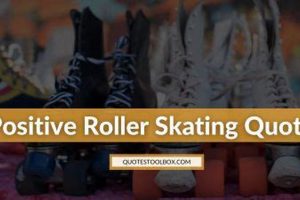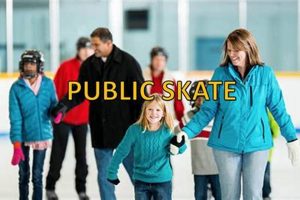Footwear designed for gliding movement across smooth, interior surfaces represents a specialized segment of recreational equipment. These items, typically featuring four wheels arranged in pairs, facilitate rolling motion. A common example involves using these devices within a gymnasium or designated skating rink.
Engaging in this activity promotes physical fitness through cardiovascular exercise and the development of lower body strength and balance. Historically, the pursuit evolved from outdoor applications to accommodate year-round enjoyment, independent of weather conditions. Furthermore, the practice offers a social outlet, often enjoyed in group settings.
The following discussion will delve into the specific considerations for selecting appropriate equipment, suitable surface types, and safety protocols related to the activity. Subsequent sections will also address maintenance procedures and explore various skill levels and techniques involved.
Tips for Indoor Roller Skating
Optimizing the indoor roller skating experience involves careful consideration of several factors. These guidelines aim to enhance safety, performance, and longevity of both equipment and skating surfaces.
Tip 1: Select Appropriate Wheels: Wheel durometer, or hardness, significantly impacts performance. Softer wheels (lower durometer) offer better grip on slick indoor surfaces, enhancing control. Harder wheels are more suitable for outdoor use.
Tip 2: Maintain Skate Cleanliness: Regular cleaning prevents dirt and debris from damaging bearings and hindering smooth rolling. Use a soft brush and a damp cloth to remove accumulated grime after each use.
Tip 3: Inspect and Tighten Components: Before each session, thoroughly inspect axles, wheel nuts, and toe stops (if applicable). Loose components compromise stability and increase the risk of accidents. Use appropriate tools for tightening.
Tip 4: Utilize Protective Gear: Helmets, wrist guards, elbow pads, and knee pads are essential for injury prevention. Ensure a snug and secure fit to maximize their protective capabilities. Replace gear following any significant impact.
Tip 5: Choose Suitable Surfaces: Opt for smooth, level, and clean surfaces. Wood floors, polished concrete, and designated skating rinks are generally appropriate. Avoid rough, uneven, or obstructed areas.
Tip 6: Practice Proper Technique: Focus on maintaining a low center of gravity and engaging core muscles for balance and stability. Consult instructional resources or seek guidance from experienced skaters to improve technique.
Tip 7: Be Aware of Surroundings: Maintain vigilance and awareness of other skaters and obstacles within the skating environment. Adhere to designated traffic patterns and exercise caution when navigating crowded areas.
Adherence to these recommendations fosters a safer and more enjoyable indoor roller skating experience. Regular maintenance and mindful practices contribute to prolonged equipment lifespan and reduced risk of injury.
The following sections will provide further details on advanced techniques and customization options for enhanced performance and personal expression.
1. Wheel Durometer Selection
The selection of appropriate wheel durometer is a critical determinant in the performance and safety of foot-mounted, wheeled devices used on interior surfaces. Durometer, a measure of a wheel’s hardness, directly influences grip, speed, and overall control. The optimal choice varies depending on the specific characteristics of the interior skating environment.
- Grip Optimization on Interior Surfaces
Softer wheels, characterized by lower durometer ratings (e.g., 78A-85A), provide enhanced grip on the typically smooth and often polished surfaces found indoors. This increased friction facilitates better control during maneuvers such as turns, stops, and starts. Insufficient grip leads to slippage, increasing the risk of falls and compromised performance.
- Speed Modulation for Controlled Movement
Harder wheels, with higher durometer ratings (e.g., 88A-101A), offer reduced rolling resistance, resulting in greater speed. However, this increased speed comes at the cost of reduced grip. Interior environments often necessitate controlled movements within limited spaces, making softer wheels a more appropriate choice to prevent overspeeding and maintain maneuverability.
- Surface Compatibility and Wear Resistance
The durometer selection should consider the type of interior surface. Extremely soft wheels may exhibit excessive wear on rougher indoor surfaces, while overly hard wheels may offer inadequate grip on particularly smooth or polished surfaces. Matching wheel hardness to the surface type optimizes both performance and wheel longevity.
- User Skill Level and Skating Style
Beginner skaters and those prioritizing stability often benefit from softer wheels, which provide more forgiving handling characteristics. Experienced skaters may prefer harder wheels for increased speed and responsiveness, but only if they possess the skill to maintain control. Skating style, whether recreational, artistic, or speed-oriented, also influences the optimal durometer choice.
In conclusion, wheel durometer selection for foot-mounted, wheeled devices within interior spaces represents a nuanced decision. Factors such as surface characteristics, user skill level, and desired performance characteristics must be carefully considered to optimize safety, control, and overall skating enjoyment. Inappropriate durometer selection can compromise both performance and safety, underscoring the importance of informed decision-making.
2. Bearing Maintenance Frequency
The operational lifespan and performance of foot-mounted, wheeled devices employed on interior surfaces are directly correlated with the frequency of bearing maintenance. Consistent upkeep ensures optimal rolling efficiency and minimizes the risk of premature bearing failure, thereby extending the usability and enhancing the safety of these devices.
- Debris Accumulation in Interior Environments
Interior environments, while often perceived as cleaner than outdoor settings, nonetheless accumulate dust, hair, and carpet fibers. These contaminants infiltrate bearing assemblies, increasing friction and impeding smooth rotation. Regular cleaning removes these accumulated particles, preventing degradation of bearing performance. Failure to address debris build-up leads to a progressive decline in rolling efficiency, necessitating increased physical exertion from the user.
- Lubricant Degradation and its Effects
Bearing lubricants, essential for minimizing friction and dissipating heat, degrade over time due to oxidation, contamination, and mechanical stress. Reduced lubrication exacerbates friction, accelerating wear and potentially leading to bearing seizure. Regular re-lubrication with appropriate bearing grease replenishes the protective film, maintaining optimal rolling characteristics and extending bearing life. The absence of adequate lubrication results in increased heat generation, potentially damaging bearing components and compromising safety.
- Impact of Skating Frequency and Intensity
Higher skating frequency and more intense activity levels accelerate bearing wear and degradation. Competitive or frequent recreational usage places greater stress on bearing assemblies, necessitating more frequent maintenance intervals. Conversely, infrequent or low-intensity usage allows for extended maintenance cycles. Adapting maintenance schedules to usage patterns optimizes bearing performance while minimizing unnecessary upkeep.
- Surface Composition and its Influence
The composition of interior skating surfaces influences the rate of bearing contamination. Carpeting, for example, sheds fibers that readily infiltrate bearings, while polished concrete may generate abrasive dust particles. Understanding the specific characteristics of the skating surface allows for tailored maintenance protocols designed to mitigate the effects of surface-specific contaminants. Regular cleaning and lubrication protocols should be adjusted accordingly to ensure optimal bearing performance in diverse indoor environments.
In conclusion, the frequency with which foot-mounted, wheeled device bearings are maintained directly impacts their performance, longevity, and the overall user experience. Regular cleaning, lubrication, and inspection, tailored to usage patterns and environmental conditions, are crucial for sustaining optimal functionality and ensuring the continued safe operation of these devices on interior surfaces. Consistent maintenance protocols contribute significantly to both the enjoyment and safety of the activity.
3. Protective Gear Adherence
The utilization of foot-mounted, wheeled devices within interior environments necessitates stringent adherence to protective gear protocols. The inherent risks associated with this activity, including falls and collisions, are amplified by the hard, unforgiving nature of typical indoor surfaces. Therefore, protective equipment serves as a critical intervention to mitigate the potential for injury, particularly in enclosed spaces where maneuverability may be limited.
Protective gear adherence for indoor roller skating is not merely a suggestion but a fundamental safety measure. Helmets absorb and dissipate impact forces, preventing or minimizing head trauma in the event of a fall. Wrist guards provide support and protection to the wrist joint, vulnerable to sprains and fractures during attempted hand placements. Elbow and knee pads shield these articulation points from abrasions, contusions, and more severe joint damage. For example, a slip on a polished floor without wrist guards can result in a Colles’ fracture, a common injury among skaters. The consistent use of appropriate gear significantly reduces the likelihood and severity of such incidents.
In conclusion, the connection between indoor roller skating and protective gear adherence is inseparable. Consistent and conscientious use of helmets, wrist guards, elbow pads, and knee pads constitutes a proactive approach to risk management. Neglecting these precautions elevates the risk of injury substantially. Prioritizing protective gear adherence fosters a safer and more enjoyable skating experience for all participants within the interior environment.
4. Surface Condition Assessment
The safe and efficient operation of foot-mounted, wheeled devices within interior environments is predicated upon thorough surface condition assessment. The characteristics of the skating surface directly impact maneuverability, stability, and the potential for accidents. Unevenness, debris, and excessive slipperiness or stickiness pose significant hazards to skaters. Prior to engaging in the activity, a comprehensive evaluation of the surface is essential to mitigate risks and optimize performance. Failure to conduct a surface condition assessment can lead to unpredictable movements, loss of control, and subsequent injuries. For instance, a small pebble or crevice on an otherwise smooth floor can cause a sudden wheel stoppage, resulting in a fall. Proper assessment includes visual inspection for obstructions, tactile evaluation for texture irregularities, and consideration of cleaning frequency and maintenance protocols.
The implementation of standardized assessment procedures within designated indoor skating facilities serves as a practical example of the importance of this practice. Regular inspections, conducted by trained personnel, identify and address potential hazards such as cracks in the flooring, accumulations of dust or spills, and variations in surface friction. Corrective actions, ranging from simple sweeping to extensive resurfacing, are then implemented to maintain a safe and predictable skating environment. Furthermore, understanding the properties of different flooring materials, such as wood, concrete, or synthetic surfaces, allows skaters to select appropriate wheel types and durometers, further enhancing control and reducing the risk of surface-related incidents. Specific situations might include adjusting wheel hardness based on whether a skating surface is polished concrete versus a less-maintained gymnasium floor.
In summary, surface condition assessment is not merely a preliminary step, but an integral component of safe and effective indoor skating practices. Proactive identification and remediation of surface imperfections minimizes the risk of accidents and maximizes the enjoyment and performance of participants. While challenges may arise in environments where surface conditions are less controlled or predictable, adherence to established assessment protocols and adaptable skating techniques remain crucial for mitigating potential hazards and ensuring a positive skating experience. This practice is fundamentally linked to promoting safety and preventing injury when operating foot-mounted, wheeled devices within enclosed spaces.
5. Skill Level Progression
The mastery of foot-mounted, wheeled devices within interior environments is a process characterized by gradual skill development. This progression, moving from novice to expert, necessitates structured learning, dedicated practice, and adaptation to the inherent challenges of indoor skating.
- Fundamental Balance and Stance
The initial stage focuses on establishing a stable and balanced stance. This involves mastering basic movements such as standing, gliding, and stopping. Novices often begin with stationary practice, gradually transitioning to controlled movement on smooth, level surfaces. For example, beginners may initially focus on maintaining balance while holding onto a support bar before attempting free skating. The acquisition of fundamental balance and stance forms the bedrock for subsequent skill development.
- Basic Maneuvers and Control
Once a foundational level of balance is achieved, the focus shifts to executing basic maneuvers such as forward skating, backward skating, and simple turns. Control is paramount, requiring skaters to develop the ability to regulate speed and direction with precision. Drills involving cone navigation and figure-eight patterns are common exercises. Mastery of these maneuvers allows skaters to navigate the indoor environment safely and confidently. For instance, a skater must competently execute a controlled turn to avoid collisions with other skaters or obstacles.
- Advanced Techniques and Agility
The intermediate stage involves the acquisition of more complex techniques, including crossovers, spins, and jumps. Agility and coordination become increasingly important as skaters attempt more demanding maneuvers. Practice sessions often incorporate elements of choreography and artistic expression. These skills enable skaters to participate in advanced skating disciplines, such as roller dance or freestyle skating. A skater proficient in crossovers can maintain speed and momentum while navigating sharp turns or crowded areas.
- Specialized Skills and Customization
The advanced stage focuses on the development of specialized skills specific to particular skating styles or disciplines. This may involve mastering complex tricks, executing synchronized routines, or optimizing equipment for specific performance requirements. Elite skaters often work with coaches and trainers to refine their technique and maximize their potential. Examples include perfecting advanced jump landings, developing intricate footwork patterns, or customizing skate components for enhanced performance. These skills represent the pinnacle of expertise in indoor roller skating.
In summary, skill level progression in indoor roller skating is a sequential and iterative process, requiring dedication, practice, and continuous refinement. Each stage builds upon the previous one, culminating in the mastery of specialized skills and the ability to perform complex maneuvers with precision and grace. Continued practice is essential for skaters seeking to maintain and improve their performance, regardless of their current skill level. The acquisition of these skills directly impacts both safety and enjoyment within the indoor skating environment.
Frequently Asked Questions
This section addresses common inquiries regarding the practice of roller skating within interior environments. The information provided aims to clarify aspects related to equipment, safety, and technique.
Question 1: Are specific wheel types necessary for indoor roller skating?
Yes, wheel durometer significantly impacts performance on interior surfaces. Softer wheels (lower durometer rating) provide enhanced grip, crucial for control on smooth indoor floors.
Question 2: What protective gear is considered essential for indoor roller skating?
Helmets, wrist guards, elbow pads, and knee pads are strongly recommended. These items mitigate the risk of injury from falls, which are common, particularly for novice skaters.
Question 3: How often should roller skate bearings be cleaned and lubricated for indoor use?
Bearing maintenance frequency depends on usage intensity and environmental conditions. Generally, cleaning and lubrication every 20-40 hours of skating is advisable. More frequent maintenance may be necessary in dusty or debris-laden environments.
Question 4: What type of indoor surfaces are suitable for roller skating?
Smooth, level surfaces such as hardwood floors, polished concrete, and designated skating rink surfaces are generally appropriate. Avoid uneven, cracked, or obstructed surfaces.
Question 5: How can one minimize the risk of accidents when skating indoors?
Maintaining awareness of surroundings, adhering to established skating patterns, utilizing appropriate protective gear, and practicing proper skating techniques are critical for accident prevention.
Question 6: Is professional instruction recommended for learning to roller skate indoors?
While not mandatory, professional instruction can accelerate skill development and enhance safety. Experienced instructors provide guidance on proper technique, balance, and injury prevention.
In summary, addressing these frequently asked questions promotes a safer and more informed approach to indoor roller skating. Adherence to recommended practices enhances the overall skating experience.
The following section will explore advanced topics, including skate customization options and strategies for optimizing performance.
Conclusion
This exploration has underscored the multifaceted nature of roller skates indoor. Wheel selection, meticulous maintenance, diligent protective gear usage, astute surface assessment, and progressive skill development constitute interdependent elements of safe and effective participation. Disregard for any of these factors elevates risk and diminishes the potential for a positive experience. The information presented aims to furnish a comprehensive understanding of the requirements and considerations necessary for responsible engagement with this activity.
The successful and safe employment of roller skates indoor requires ongoing vigilance and adherence to established best practices. Continued education and proactive risk management are crucial for fostering a culture of safety and promoting the longevity of participation within indoor skating environments. The pursuit of excellence in this activity demands a commitment to both personal skill development and responsible stewardship of skating resources and spaces.







